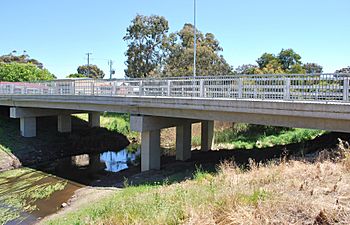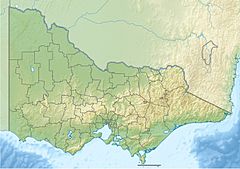Mount Emu Creek facts for kids
Quick facts for kids Mount Emu(Tarnpirr) |
|
|---|---|

The Mount Emu Creek flowing under a bridge that carries the Glenelg Highway, near Skipton.
|
|
| Country | Australia |
| State | Victoria |
| Region | Victorian Midlands, Naracoorte Coastal Plain (IBRA), Western District |
| Local government areas | Pyrenees, Ararat, Moyne |
| Towns | Beaufort, Skipton, Darlington, Terang, Panmure |
| Physical characteristics | |
| Main source | north of Trawalla 405 m (1,329 ft) 37°20′27″S 143°31′48″E / 37.34083°S 143.53000°E |
| River mouth | confluence with Hopkins River near Cudgee, northeast of Warrnambool 28 m (92 ft) 38°19′36″S 142°38′22″E / 38.32667°S 142.63944°E |
| Length | 250 km (160 mi) |
| Basin features | |
| River system | Glenelg Hopkins catchment |
| Tributaries |
|
The Mount Emu Creek is a beautiful waterway in the Western District of Victoria, Australia. Its Aboriginal Australian name is Tarnpirr. This creek flows all year round, making it a perennial creek. It is part of the larger Glenelg Hopkins river system.
Contents
About Mount Emu Creek
The Mount Emu Creek is a long and winding waterway. It stretches for about 250-kilometre (160 mi). This makes it the longest creek in all of Victoria.
Where the Creek Begins and Ends
The creek starts near a place called Trawalla. From there, it flows mostly towards the south and southwest. Along its journey, six smaller creeks join it. Finally, it meets the Hopkins River near Cudgee, which is northeast of Warrnambool.
The creek drops about 377 metres (1,237 ft) in height over its 271-kilometre (168 mi) path. Mount Emu Creek is the most important waterway in the Hopkins river area. Many small creeks and gullies feed into it from the east and west.
Towns and Connections
The Mount Emu Creek begins as several small waterways that come together. It then flows through towns like Beaufort, Skipton, Darlington, Terang, and Panmure.
The creek eventually joins the Hopkins River. The Hopkins River then flows out to the sea at Warrnambool.
Other Waterways Joining the Creek
- The Baillie Creek flows from Lake Burrumbeet into Mount Emu Creek. This happens west of Snake Valley.
- The Elingamite Creek flows from Lake Elingamite into Mount Emu Creek. This connection is south of Terang.
Bridges Over the Creek
Several major roads cross over the Mount Emu Creek:
- The Western Highway crosses it near Trawalla.
- The Glenelg Highway crosses it at Skipton.
- The Hamilton Highway goes over it at Darlington.
- The Princes Highway crosses it near Terang.
Fishing in Mount Emu Creek
Mount Emu Creek is a very popular spot for fishing. Both local people and visitors enjoy fishing here. You can even catch very large brown trout in this creek.
Fish Species and Stocking
The creek often gets new brown trout added to it. This is done by the Department of Natural Resources and Environment. The Terang Angling Club also helps with this. There are also some native brown trout living in the creek.
Most fish caught weigh around 1,000 grams (35 oz). However, some much larger "trophy" sized trout can be found.
Popular Fishing Spots
Some of the best places to fish include:
- McKinnons bridge
- Castlecary Road bridge
- Ayresford Road
- Panmure bridge
Besides trout, you can also catch other fish like redfin, eels, tench, tupong, and black fish. In some areas between Pura Pura and Darlington, people have caught yellowbelly using worms.
Platypuses in the Creek
Mount Emu Creek is home to many amazing platypuses. It also has a lot of redfin fish, which platypuses like to eat.
Platypus Research and Breeding
Surveys done in 1991 and 1996 showed that platypuses are successfully having babies right in the middle of Skipton town. There is even a special platform at Stewart Park in the town center. You can use it to watch the platypuses.
In August 2003, the Australian Platypus Conservancy did an all-night study. They worked with Skipton's Stewart Park Committee. They found six platypuses in a 5-kilometre (3.1 mi) part of the creek. One of them was a baby female. She weighed 680 grams (24 oz). This tiny platypus had probably just left her burrow for the first time about a week before.
Geoff Williams, a biologist, said the young platypus was very healthy. Her presence confirmed that platypuses are breeding well in the township.
See also



